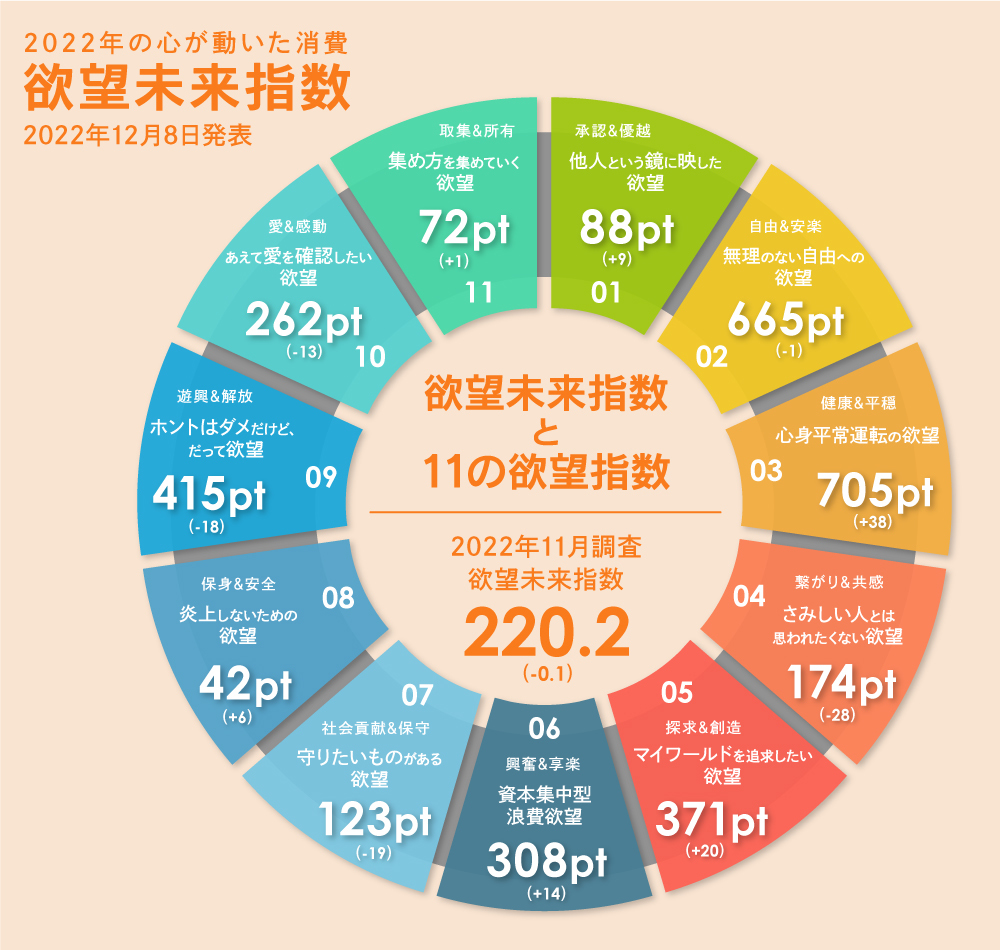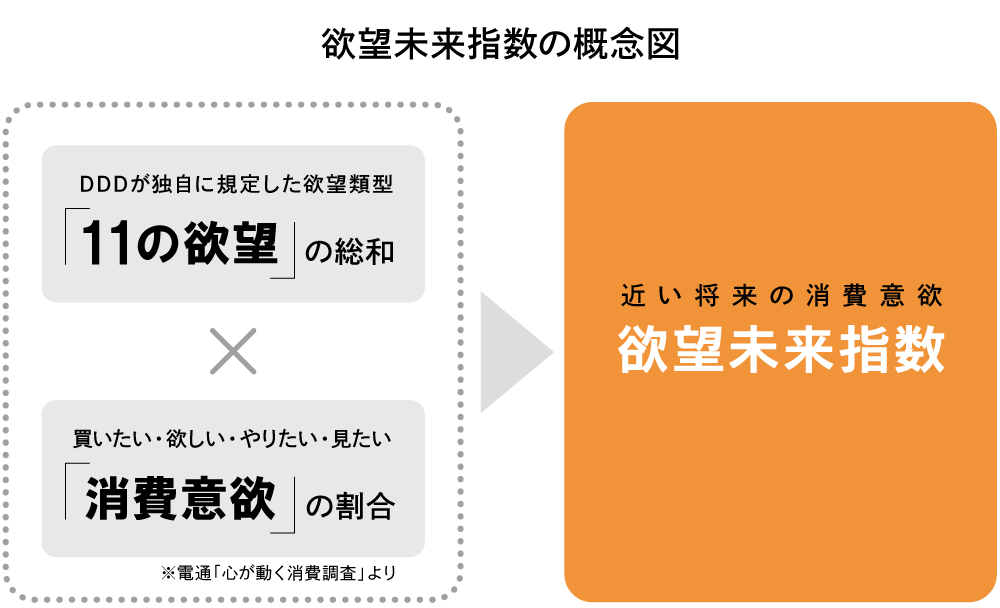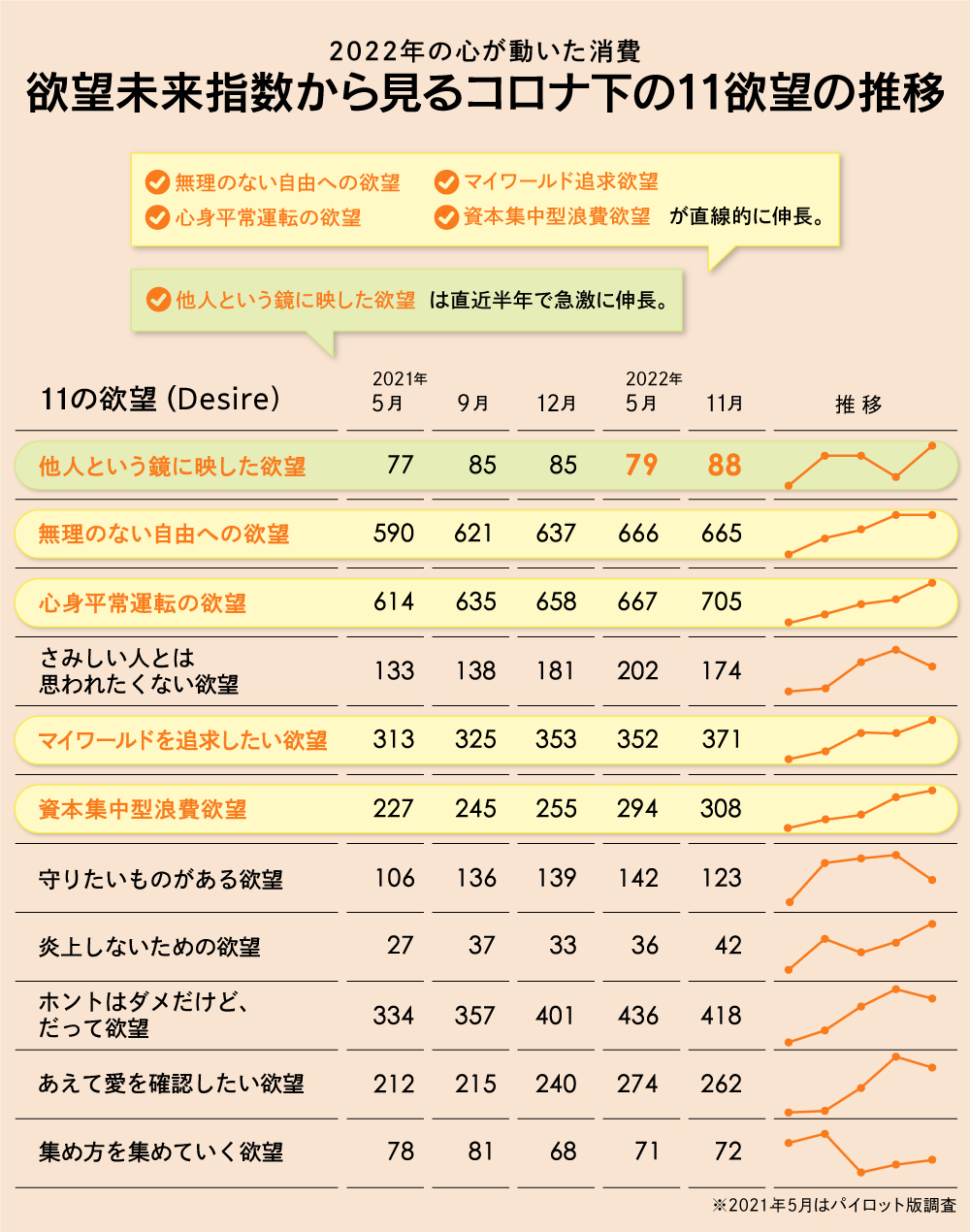DENTSU DESIRE DESIGN (DDD) is a project aiming to unravel the modern consumer profile, which has become increasingly elusive to companies, by revisiting consumer consciousness rooted in "Desire."
In this series, DDD members will introduce their approach to consumer insights rooted in "Desire" and future developments.
The "11 Desires" identified by DDD through its activities.Previous articles introduced how these desires can be clustered (typed) based on the degree each individual possesses them. However, these "11 Desires" do not exist with equal intensity.
This time, we introduce the "Desire Future Index," developed to quantify the "11 Desires" held by today's consumers and visualize the desires of consumers just one step ahead.
Visualizing "Want to Buy/Want/Want to Do/Want to See" Intentions and Desire Fluctuations
While "data marketing" to capture emerging consumer needs has been widely adopted by many companies in recent years, predicting consumption trends and economic conditions has become extremely difficult due to changes in lifestyle and social environment driven by international circumstances, rising prices, and rapid digitalization.
While several indicators exist to measure consumers' current financial situations and economic perceptions—such as the Economic Trends Index (※1) and the Consumer Price Index (※2)—we aimed to create an indicator that forecasts consumer motivation and desires in the near future. This led to the development of the "Desire Future Index."
※1 = Economic Trends Index
This index was created to aid in understanding the current state of the economy and forecasting its future by integrating movements in key indicators sensitive to economic conditions across various economic activities, such as production and employment. For details, click here.
※2 = Consumer Price Index
Measures price fluctuations over time by aggregating the prices of goods and services related to household expenditures nationwide. It then fixes the composition of household consumption and indicates, as an index value, how the cost of this fixed consumption changes due to price fluctuations. For details, click here.
We believe that by combining consumers' current "11 Desires" with their future consumption intentions, we can visualize not only explicit needs but also the underlying latent consumption desires of people.
Therefore, based on DDD's core survey, the "Heart-Moving Consumption Survey" ( survey overview here ), we calculated the "Desire Future Index" by multiplying the percentage (total sum) of people who reported that their "11 Desires"—composed of 43 distinct desire items we uniquely defined for modern consumers—were satisfied by their most recent consumption, with their near-future consumption intent (the percentage of people with a certain level of desire to "buy" "want to buy," "want to have," "want to do," "want to see") were multiplied to calculate the "Desire Future Index."
The "Desire Future Index" in the chart below, based on the November 2022 survey results, indicates the projected level of the 11 desires in the near future.

*Numbers in parentheses indicate the difference from the previous survey. Since figures are rounded to the first decimal place, the differences may not match those shown in the chart "Changes in 11 Desires During COVID-19 as Seen Through the Desire Future Index."
Trends in 11 Desires Seen Through the Desire Future Index
Looking at the trend of the "Desire Future Index," calculated based on survey results from May 2021, when the "Heart-Moving Consumption" survey began, to November 2022, four desires show a steady upward trend. Let's examine each one, including its content and the factors thought to have contributed to this trend.
1."Desire for Freedom Without Strain"
In the past, freedom was something one fought to win. Today, however, freedom tends to be sought as something attainable and maintainable within reach. This trend is evident in recent popular themes like manga featuring "reincarnation" or "alternate worlds" where one can go to another world as their true self and dominate effortlessly, or workation, which allows enjoying hobbies while working.
2."The Desire for Physical and Mental Equilibrium"
Since the spread of the novel coronavirus, the desire for physical and mental normalcy has continued to grow. The popularity of sleep-care beverages and products can be attributed to the fact that, in our stressful daily lives, improving sleep duration and quality is seen as a way to achieve a "state where both mind and body are problem-free" – something many people aspire to.
3."The Desire to Pursue My Own World"
As introduced in the 8th article, a behavioral trend called "Kyodoku" (solitary dwelling) is spreading. This involves creating personal time and space in daily life to immerse oneself in favorite activities, seeking reset and relaxation through self-reflection. The desire to value time pursuing one's own world, such as through online learning or personalized services, is definitely increasing.
4."Capital-Concentrated Wasteful Desire"
Amidst external factors like a weak yen and rising prices that could curb consumption, there's also a growing desire to loosen the purse strings completely for that one chosen world, pursuing self-realization. This connects to the "desire to pursue one's own world," and it seems consumers are increasingly adopting a mindset of creating significant contrasts within their own lives.
Furthermore, while not on an upward trajectory, "desires reflected in the mirror of others" have surged significantly over the past six months. With restrictions to prevent the spread of COVID-19 lifted, and the desire to go out increasing, this is thought to be an emerging manifestation of the desire to have one's efforts and hard work recognized and responded to by others. Its future trajectory warrants attention.
We plan to conduct the sixth "Heart-Moving Consumption" survey this May. We will continue to share insights into the desires of modern consumers.
Dentsu Inc. Desire Design Project will continue to address various marketing challenges. Interested parties are welcome to contact us below.
[Contact Information]
DENTSU DESIRE DESIGN (Dentsu Inc. Design)
Email: ddd-project@dentsu.co.jp
【Survey Overview】
Title: Dentsu Inc. "Heart-Moving Consumption Survey"
Survey Purpose: Analyze consumer consciousness, increasingly difficult to visualize due to a constantly changing social environment, from the perspective of consumer desire, and interpret the future of Japan's consumer society.
Target Area: Nationwide, Japan
Respondent Criteria: Ages 20–74
Sample Size: 3,000 samples (allocated according to population ratios across 6 age groups [20s-70s] and 2 gender categories)
Survey Method: Internet survey
Survey Period: May 2021 to November 2022, conducted 5 times in total
Research Institution: Dentsu Macromill Insight, Inc.










